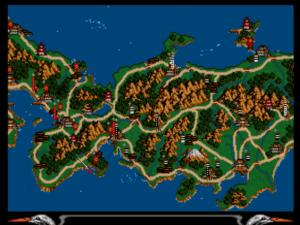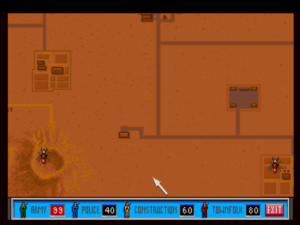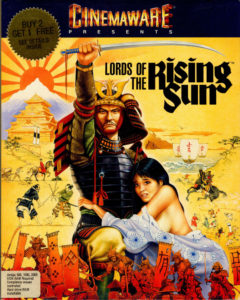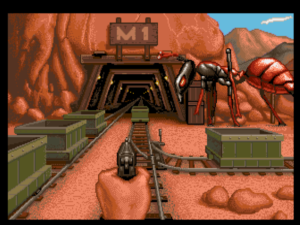The last year of the 1980s was also the last that the Commodore Amiga would enjoy as the ultimate American game machine. Even as the low-end computer-game market was being pummeled into virtual nonexistence by the Nintendo Entertainment System, leaving the Amiga with little room into which to expand downward, the heretofore business-centric world of MS-DOS was developing rapidly on the high end, with VGA graphics and sound cards becoming more and more common. The observant could already recognize that these developments, combined with Commodore’s lackadaisical attitude toward improving their own technology, must spell serious trouble for the Amiga in the long run.
But for now, for this one more year, things were still going pretty well. Amiga zealots celebrated loudly and proudly at the beginning of 1989 when news broke that the platform had pushed past the magic barrier of 1 million machines sold. As convinced as ever that world domination was just around the corner for their beloved “Amy,” they believed that number would have to lead to her being taken much more seriously by the big non-gaming software houses. While that, alas, would never happen, sales were just beginning to roll in many of the European markets that would sustain the Amiga well into the 1990s.
This last positive development fed directly into the bottom line of Cinemaware, the American software house that was the developer most closely identified with the Amiga to a large extent even in Europe. Cinemaware’s founder Bob Jacob wisely forged close ties with the exploding European Amiga market via a partnership with the British publisher Mirrorsoft. In this way he got Cinemaware’s games wide distribution and promotion throughout Europe, racking up sales across the pond under the Mirrorsoft imprint that often dramatically exceeded those Cinemaware was able to generate under their own label in North America. The same partnership led to another welcome revenue stream: the importation of European games into Cinemaware’s home country. Games like Speedball, by the rockstar British developers The Bitmap Brothers, didn’t have much in common with Cinemaware’s usual high-concept fare, but did feed the appetite of American youngsters who had recently found Amiga 500s under their Christmas trees for splashy, frenetic, often ultra-violent action.
Yet Cinemaware’s biggest claim to fame remained their homegrown interactive movies — which is not to say that everyone was a fan of their titular cinematic approach to game-making. A steady drumbeat of criticism, much of it far from unjustified, had accompanied the release of each new interactive movie since the days of Defender of the Crown. Take away all of the music and pretty pictures that surrounded their actual game play, went the standard line of attack, and these games were nothing but shallow if not outright broken exercises in strategy attached to wonky, uninteresting action mini-games. Cinemaware clearly took the criticism to heart despite the sales success they continued to enjoy. Indeed, the second half of the company’s rather brief history can to a large extent be read as a series of reactions to that inescapable negative drumbeat, a series of attempts to show that they could make good games as well as pretty ones.
At first, the new emphasis on depth led to decidedly mixed results. Conflating depth with difficulty in a manner akin to the way that so many adventure-game designers conflate difficulty with unfairness, Cinemaware gave the world Rocket Ranger as their second interactive movie of 1988. It had all the ingredients to be great, but was undone by balance issues exactly the opposite of those which had plagued the prototypical Cinemaware game, Defender of the Crown. In short, Rocket Ranger was just too hard, a classic game-design lesson in the dangers of overcompensation and the importance of extensive play-testing to get that elusive balance just right. With two more new interactive movies on the docket for 1989, players were left wondering whether this would be the year when Cinemaware would finally get it right.
Certainly they showed no sign of backing away from their determination to bring more depth to their games. On the contrary, they pushed that envelope still harder with Lords of the Rising Sun, their first interactive movie of 1989. At first glance, it was a very typical Cinemaware confection, a Defender of the Crown set in feudal Japan. Built like that older game from the tropes and names of real history without bothering to be remotely rigorous about any of it, Lords of the Rising Sun is also another strategy game broken up by action-oriented minigames — the third time already, following Defender of the Crown and Rocket Ranger, that Cinemaware had employed this template. This time, however, a concerted effort was made to beef up the strategy game, not least by making it into a much more extended affair. Lords of the Rising Sun became just the second interactive movie to include a save-game feature, and in this case it was absolutely necessary; a full game could absorb many hours. It thus departed more markedly than anything the company had yet done from Bob Jacob’s original vision of fast-playing, non-taxing, ultra-accessible games. Indeed, with a thick manual and a surprising amount of strategic and tactical detail to keep track of, Lords of the Rising Sun can feel more like an SSI than a typical Cinemaware game once you look past its beautiful audiovisual presentation. Reaching for the skies if not punching above their weight, Cinemaware even elected to include the option of playing the game as an exercise in pure strategy, with the action sequences excised.
But sadly, the strategy aspect is as inscrutable as a Zen koan. While Rocket Ranger presents with elegance and grace a simple strategy game that would be immensely entertaining if it wasn’t always kicking your ass, Lords of the Rising Sun is just baffling. You’re expected to move your armies over a map of Japan, recruiting allies where possible, fighting battles to subdue enemies where not. Yet it’s all but impossible to divine any real sense of the overall situation from the display. This would-be strategy game ends up feeling more random than anything else, as you watch your banners wander around seemingly of their own volition, bumping occasionally into other banners that may represent enemies or friends. It suffers mightily from a lack of clear status displays, making it really, really hard to keep track of who wants to do what to whom. If you have the mini-games turned on, the bird’s-eye view is broken up by arcade sequences that are at least as awkward as the strategy game. In the end, Lords of the Rising Sun is just no fun at all.

While it’s very pretty, Lords of the Rising Sun‘s animated, scrolling map is nicer to look at than it is a practical tool for strategizing.
Press and public alike were notably unkind to Lords of the Rising Sun. Claims like Bob Jacob’s that “there is more animation in Lords than has ever been done in any computer game” — a claim as unquantifiable as it was dubious, especially in light of some of Sierra’s recent efforts — did nothing to shake Cinemaware’s reputation for being all sizzle, no steak. Ken St. Andre of Tunnels & Trolls and Wasteland fame, reviewing the game for Questbusters magazine, took Cinemaware to task on its every aspect, beginning with the excruciating picture on the box of a cowering maiden about to fall out of her kimono; he deemed it “an insult to women everywhere and to Japanese culture in particular.” (Such a criticism sounds particularly forceful coming from St. Andre; Wasteland with its herpes-infested prostitutes and all the rest is hardly a bastion of political correctness.) He concluded his review with a zinger so good I wish I’d thought of it: he called the game “a Japanese Noh play.”
Many other reviewers, while less boldly critical, seemed nonplussed by the whole experience — a very understandable reaction to the strategy game’s vagaries. Sales were disappointing in comparison to those of earlier interactive movies, and the game has gone down in history alongside the equally underwhelming S.D.I. as perhaps the least remembered of all the Cinemaware titles.
So, what with the game-play criticisms beginning to affect the bottom line, Cinemaware really needed to deliver something special for their second game of 1989. Thankfully, It Came from the Desert would prove to be the point where they finally got this interactive-movie thing right, delivering at long last a game as nice to play as it is to look at.
It Came from the Desert was the first of the interactive movies not to grow from a seed of an idea planted by Bob Jacob himself. Its originator was rather David Riordan, a newcomer to the Cinemaware fold with an interesting career in entertainment already behind him. As a very young man, he’d made a go of it in rock music, enjoying his biggest success in 1970 with a song called “Green-Eyed Lady,” a #3 hit he co-wrote for the (briefly) popular psychedelic band Sugarloaf. A perennial on Boomer radio to this day, that song’s royalties doubtless went a long way toward letting him explore his other creative passions after his music career wound down. He worked in movies for a while, and then worked with MIT on a project exploring the interactive potential of laser discs. After that, he worked briefly for Lucasfilm Games during their heady early days with Peter Langston at the helm. And from there, he moved on to Atari, where he worked on laser-disc-driven stand-up arcade games until it became obvious that Dragon’s Lair and its spawn had been the flashiest of flashes in the pan.
Riordan’s resume points to a clear interest in blending cinematic approaches with interactivity. It thus comes as little surprise that he was immediately entranced when he first saw Defender of the Crown one day at his brother-in-law’s house. It had, he says, “all the movie attributes and approaches that I had been trying to get George Lucas interested in” while still with Lucasfilm. He wrote to Cinemaware, sparking up a friendship with Bob Jacob which led him to join the company in 1988. Seeing in Riordan a man who very much shared his own vision for Cinemaware, Jacob relinquished a good deal of the creative control onto which he had heretofore held so tightly. Riordan was placed in charge of the company’s new “Interactive Entertainment Group,” which was envisioned as a production line for cranking out new interactive movies of far greater sophistication than those Cinemaware had made to date. These latest and greatest efforts were to be made available on a whole host of platforms, from their traditional bread and butter the Amiga to the much-vaunted CD-based platforms now in the offing from a number of hardware manufacturers. If all went well, It Came from the Desert would mark the beginning of a whole new era for Cinemaware.

Here we can see — just barely; sorry for this picture’s terrible fidelity — Cinemaware’s scripting tool MasterPlan.
Cinemaware spent months making the technology that would allow them to make It Came from the Desert. Riordan’s agenda can be best described as a desire to free game design from the tyranny of programmers. If this new medium was to advance sufficiently to tell really good, interesting interactive stories, he reasoned, its tools would have to become something that non-coding “real” writers could successfully grapple with. Continuing to advance Cinemaware’s movie metaphors, his team developed a game engine that could largely be “scripted” in point-and-click fashion in HyperCard rather than needing to be programmed in any conventional sense. Major changes to the structure of a game could be made without ever needing to write a line of code, simply by editing the master plan of the game in a HyperCard tool Cinemaware called, appropriately enough, MasterPlan. The development process leveraged the best attributes of a number of rival platforms: Amigas ran the peerless Deluxe Paint for the creation of art; Macs ran HyperCard for the high-level planning; fast IBM clones served as the plumbing of the operation, churning through compilations and compressions. It was by anyone’s standards an impressive collection of technology — so impressive that the British magazine ACE, after visiting a dozen or more studios on a sort of grand tour of the American games industry, declared Cinemaware’s development system the most advanced of them all. Cinemaware had come a long way from the days of Defender of the Crown, whose development process had consisted principally of locking programmer R.J. Mical into his office with a single Amiga and a bunch of art and music and not letting him out again until he had a game. “If we ever get a real computer movie,” ACE concluded, “this is where it’s going to come from.”
While it’s debatable whether It Came from the Desert quite rises to that standard, it certainly is Cinemaware’s most earnest and successful attempt at crafting a true interactive narrative since King of Chicago. The premise is right in their usual B-movie wheelhouse. Based loosely on the campy 1950s classic Them!, the game takes place in a small desert town with the charming appellation of Lizard Breath that’s beset by an alarming number of giant radioactive ants, product of a recent meteor strike. You play a geologist in town; “the most interesting rocks always end up in the least interesting places,” notes the introduction wryly. Beginning in your cabin, you can move about the town and its surroundings as you will, interacting with its colorful cast of inhabitants via simple multiple-choice dialogs and getting into scrapes of various sorts which lead to the expected Cinemaware action sequences. Your first priority is largely to convince the townies that they have a problem in the first place; this task you can accomplish by collecting enough evidence of the threat to finally gain the attention of the rather stupefyingly stupid mayor. Get that far, and you’ll be placed in charge of the town’s overall defense, at which point a strategic aspect joins the blend of action and adventure to create a heady brew indeed. Your ultimate goal, which you have just fifteen days in total to accomplish, is to find the ants’ main nest and kill the queen.
It Came from the Desert excels in all the ways that most of Cinemaware’s interactive movies excel. The graphics and sound were absolutely spectacular in their day, and still serve very well today; you can well-nigh taste the gritty desert winds. What makes it a standout in the Cinemaware catalog, however, is the unusual amount of attention that’s been paid to the design — to you the player’s experience. A heavily plot-driven game like this could and usually did go only one way in the 1980s. You probably know what I’m picturing: a long string of choke points requiring you to be in just the right place at just the right time to avoid being locked out of victory. Thankfully, It Came from the Desert steers well away from that approach. The plot is a dynamic thing rolling relentlessly onward, but your allies in the town are not entirely without agency of their own. If you fail to accomplish something, someone else might just help you out — perhaps not as quickly or efficiently as one might ideally wish, but at least you still feel you have a shot.
And even without the townies’ help, there are lots of ways to accomplish almost everything you need to. The environment as a whole is remarkably dynamic, far from the static set of puzzle pieces so typical of more traditional adventure games of this era and our own. There’s a lot going on under the hood in this one, far more than Cinemaware’s previous games would ever lead one to expect. Over the course of the fifteen days, the town’s inhabitants go from utterly unconcerned about the strange critters out there in the desert to full-on, backs-against-the-wall, fight-or-flight panic mode. By the end, when the ants are roaming at will through the rubble that once was Lizard Breath destroying anything and anyone in their path, the mood feels far more apocalyptic than that of any number of would-be “epic” games. One need only contrast the frantic mood at the end of the game with the dry, sarcastic tone of the beginning — appropriate to an academic stranded in a podunk town — to realize that one really does go on a narrative journey over the few hours it takes to play.
Which brings me to another remarkable thing: you can’t die in It Came from the Desert. If you lose at one of the action games, you wake up in the hospital, where you have the option of spending some precious time recuperating or trying to escape in shorter order via another mini-game. (No, I have no idea why a town the size of Lizard Breath should have a hospital.) In making sure that every individual challenge or decision doesn’t represent a zero-sum game, It Came from the Desert leaves room for the sort of improvisational derring-do that turns a play-through into a memorable, organic story. It’s not precisely that knowledge of past lives isn’t required; you’re almost certain to need several tries to finally save Lizard Breath. Yet each time you play you get to live a complete story, even if it is one that ends badly. Meanwhile you’re learning the lay of the land, learning to play more efficiently and getting steadily better at the action games, which are themselves unusually varied and satisfying by Cinemaware’s often dodgy standards. There are not just many ways to lose It Came from the Desert but also many paths to victory. Win or lose, your story in It Came from the Desert is your story; you get to own it. There’s a save-game feature, but I don’t recommend that you use it except as a bookmark when you really do need to do something else for a while. Otherwise just play along and let the chips fall where they may. At last, here we have a Cinemaware interactive movie that’s neither too easy nor too hard; this one is just right, challenging but not insurmountable.

It Came from the Desert evolves into a strategy game among other things, as you deploy the town’s forces to battle each new ant infestation while you continue the search for the main hive.
Widely and justifiably regarded among the old-school Amiga cognoscenti of today as Cinemaware’s finest hour, It Came from the Desert was clearly seen as something special within Cinemaware as well back in the day; one only has to glance at contemporary comments from those who worked on the game to sense their pride and excitement. There was a sense both inside and outside their offices that Cinemaware was finally beginning to crack a nut they’d been gnawing on for quite some time. Even Ken St. Andre was happy this time. “Cinemaware’s large creative team has managed to do a lot of things very well indeed in this game,” he wrote, “and as a result they have produced a game that looks great, sounds great, moves along at a rapid pace, is filled with off-the-wall humor without being dumb, and is occasionally both gripping and exciting.”
When It Came from the Desert proved a big commercial success, Cinemaware pulled together some ideas that had been left out of the original game due to space constraints, combined them with a plot involving the discovery of a second ant queen, and made it all into a sequel subtitled Ant-Heads!. Released at a relatively low price only as an add-on for the original game — thus foreshadowing a practice that would get more and more popular as the 1990s wore on — Ant-Heads! was essentially a new MasterPlan script that utilized the art and music assets from the original game, a fine demonstration of the power of Cinemaware’s new development system. It upped the difficulty a bit by straitening the time limit from fifteen days to ten, but otherwise played much like the original — which, considering how strong said original had been, suited most people just fine.
It Came from the Desert, along with the suite of tools used to create it, might very well have marked the start of exactly the new era of more sophisticated Cinemaware interactive movies that David Riordan had intended it to. As things shook out, however, it would have more to do with endings than beginnings. Cinemaware would manage just one more of these big productions before being undone by bad decisions, bad luck, and a changing marketplace. We’ll finish up with the story of their visionary if so often flawed games soon. In the meantime, by all means go play It Came from the Desert if time and motivation allow. I was frankly surprised at how well it still held up when I tackled it recently, and I think it just might surprise you as well.
(Sources: The One from April 1989, June 1989, and June 1990; ACE from April 1990; Commodore Magazine from November 1988; Questbusters from September 1989, February 1990, and May 1990; Matt Barton’s interview with Bob Jacob on Gamasutra.)













